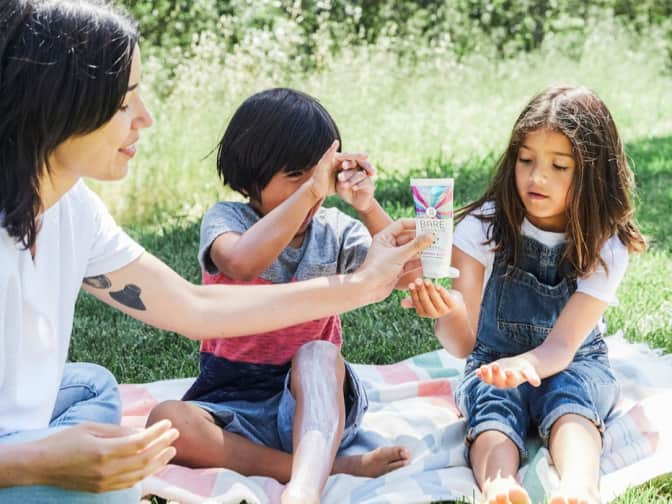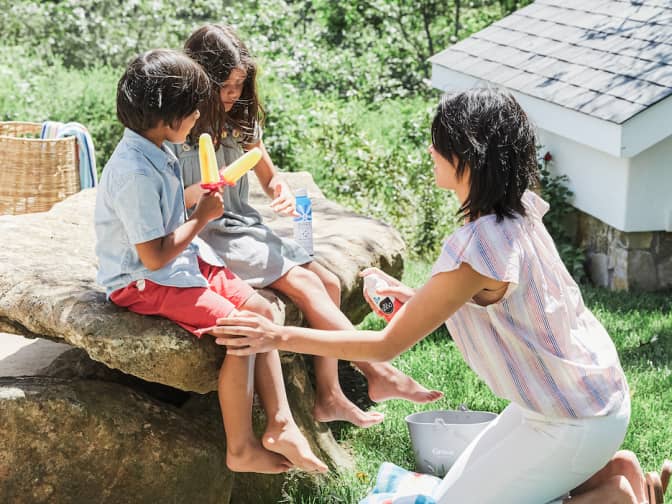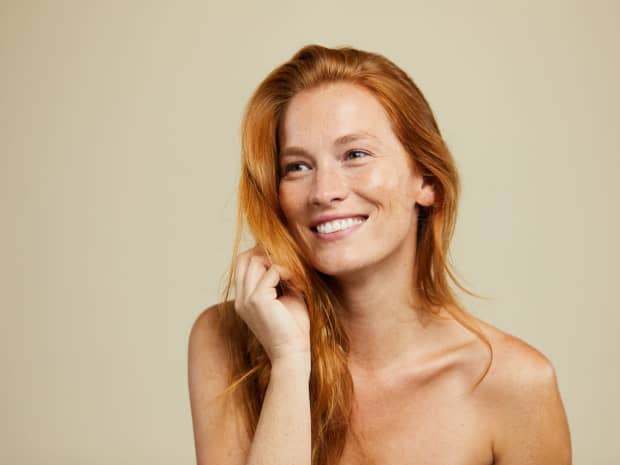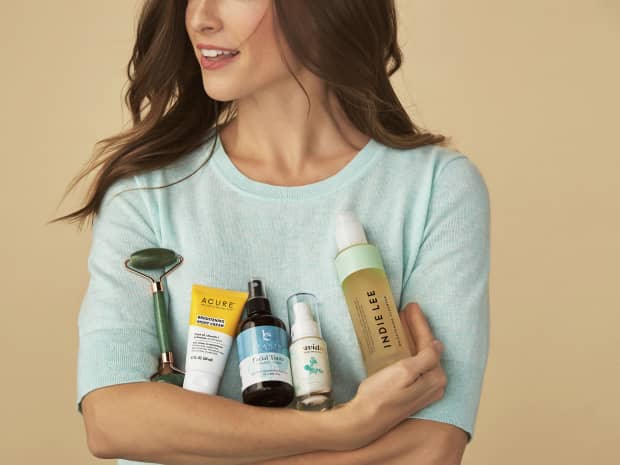
The 8 Best Natural Sunscreen Products.
We've pulled the top 8 natural sunscreens as determined by Grove members. Have a look to see if one is best for your needs!
Read More


Last Updated: July 20, 2022
From reef-safe sunscreen to broad spectrum protection, our natural sunscreen guide breaks down the top terms to know and common ingredients to avoid.
We all know that sunscreen helps prevent sunburns, skin damage, and skin cancer, but it can feel like you need a chemistry degree just to suss out which product to choose. What is a natural sunscreen? What’s the difference between natural and conventional sunscreen? And how do you know if the sunscreen you’ve chosen is safe and doing its job of preventing sun damage? We’ve got you covered.

Natural sunscreen is also known as mineral or physical sunscreen because it uses zinc oxide, titanium dioxide, or a combination of the two to block and reflect the sun’s harmful rays away from your skin.
Many certified natural organic sunscreen products are also free of other potentially harmful chemicals like parabens and phthalates. Most sunscreens on the drugstore shelves are chemical sunscreens — this means that they use chemicals like oxybenzone and avobenzone to absorb UV rays. FDA research shows that after a single application, the chemicals in sunscreen can be detected in the body at potentially harmful levels. Here is a list of 12 chemical ingredients the American Academy of Dermatology Association has called out as potentially unsafe.
Zinc oxide and titanium dioxide are the only two active sunscreen ingredients (of the 16 currently allowed in the U.S.) that are generally recognized as safe and effective by the FDA.
Oxybenzone — a chemical sunscreen ingredient that’s made from petroleum and used in 70 percent of sunscreens — and octinoxate are believed to be endocrine disruptors. This means they may mimic and interfere with your hormones. According to the FDA, chemical sunscreen ingredients like oxybenzone can be absorbed through the skin and enter the bloodstream.
Scientists have estimated that 14,000 tons of sunscreen end up in oceans around the world each year. Much of that sunscreen contains oxybenzone and octinoxate, which contribute to coral bleaching. Even in small doses, oxybenzone has been shown to quickly bleach coral and slow its growth.
While reef-safe sunscreen is vital when you are snorkeling and lounging on the beach, the sunblock you wear at the pool or on a hike matters too. Sunscreen washed off in the shower can flow through water treatment systems into local waterways or the ocean.
Chemical sunscreen absorbs the UV rays, which creates heat that can irritate your skin. The chemicals themselves can also sting or burn when applied.
Sunscreens made with zinc oxide and titanium dioxide also offer instant protection, unlike chemical sunscreens that need to absorb into your skin for 15 to 30 minutes before they can provide full protection.
Did you know?
Hawaii banned the sale of oxybenzone and octinoxate sunscreens starting in January 2021.

“Choosing a sunscreen with a mineral active ingredient is the most important thing you can do, but also check out the inactive ingredients,” says Badger director of sales Iris Piedmont-Fleischmann. “A lot of junk can hide in this lower part of the label.”
"Mineral," "physical," and "natural" are often used interchangeably to describe sunscreen that uses minerals — zinc oxide and/or titanium dioxide — to reflect or physically block the sun’s UV rays from penetrating your skin.
The sun radiates two types of harmful UV light: UVA and UVB. UVA rays can cause age spots and wrinkling, and UVB rays are responsible for sunburns. Broad-spectrum sunscreen helps protect skin cells from both.
Common sunscreen chemicals — oxybenzone and octinoxate — contribute to coral bleaching. Reef-safe sunscreen is formulated without these harmful chemicals.
Did you know?
Sunscreens that aren’t labeled as broad-spectrum often only protect against UVB rays and leave your skin vulnerable to lasting damage.

Here’s what to look for when buying natural sunscreen:
1. Zinc oxide and/or titanium dioxide as the only active ingredients
2. Broad spectrum (UVA and UVB) protection
3. No questionable ingredients like parabens (see “list of ingredients to avoid” above)
4. Water resistant (if you will be sweating or swimming)

Not necessarily. Sun protection factor (SPF) represents how well the sunscreen protects against UVB rays. There is currently no rating for UVA protection. When applied correctly, SPF 15 sunscreen blocks 93 percent of UVB rays, SPF 30 blocks almost 97 percent of UVB radiation, and SPF 50 blocks only a single percent more. SPF 100 blocks around 99 percent, which sounds great on the surface, but it may tempt people to stay in the sun too long and actually get more sun exposure than they would have if they had reapplied more frequently with a lower SPF, according to the Environmental Working Group.
The bottom line: The American Academy of Dermatology Association and the Skin Cancer Foundation recommend using sunscreens that are SFP 30 or higher. Properly applying — and reapplying! — your sunscreen is more important than a high SPF.
Did you know?
SPF 30 and SPF 60 last the same amount of time. Rather than signifying how long you can safely be in the sun, the SPF number is actually related to the amount of solar exposure you are protected from. UV rays are strongest between 10 a.m. and 4 p.m. during the summer, which means you will get more solar exposure and have a higher chance of getting a sunburn in the afternoon than you would in the morning.
No sunscreen is effective if you don’t use it correctly. Follow these tips to get the best protection possible.
“The biggest mistake with applying any sunscreen is that most people don’t use the recommended amount,” says Chris Birchby, founder and CEO of COOLA Suncare and Bare Republic.
Adults should use at least a shot glass full of sunscreen when minimally dressed to evenly cover the body, from the tops of the feet to the hairline. A half teaspoon or so should be used to cover your face, neck, and chest. If you apply less, you get less coverage and less protection. Using just half the required amount of an SPF 30 sunscreen only provides an effective SPF of 5.5, according to Piedmont-Fleischmann.
Birchby recommends applying your sunscreen in layers and working in sections. To achieve the recommended amount, start with a little bit at a time and allow it to absorb and set before applying another sheer layer. Sunscreen lotions, gels, and sticks are the easiest and safest to apply properly. And it sounds like a no-brainer, but it bears repeating: Follow the instructions on the specific product for the best results.
Don’t forget often-missed spots like your lips, the tops of your ears and feet, and your eyelids. And make sure you wear sunscreen even on cloudy days or indoors — UV rays pass through clouds and glass.
People more prone to sunburn may need to reapply more frequently, especially when the forecasted UV index is high.
A moisturizer with sunscreen is great for the commute to work, but a hike or a run calls for a water-resistant sunscreen with more protection from the sun’s harmful rays.
The bottle will tell you if the sunscreen is water resistant for 40 or 80 minutes. Be sure to reapply on time!
Applying sunscreen properly is important, but so is seeking out shade, wearing sun protective clothing (like a hat and/or UPF clothing), and following the daily UV forecast so you can avoid peak hours and safely enjoy the outdoors when UV radiation exposure is lower.
Did you know?
It only takes 15 minutes of sun exposure for UV rays to damage your skin, according to the Centers for Disease Control and Prevention.

We've pulled the top 8 natural sunscreens as determined by Grove members. Have a look to see if one is best for your needs!

A breakdown of natural self and sunless tanners, including tips and mistakes to avoid.

“You look amazing! How did you get your skin so dry?” said no one ever. The struggle of finding the right routine for dry skin is real. We're here for you.

Plant-based squalane oil is touted as a highly hydrating, extra-gentle facial oil with anti-aging properties that make it a win for aging skin.